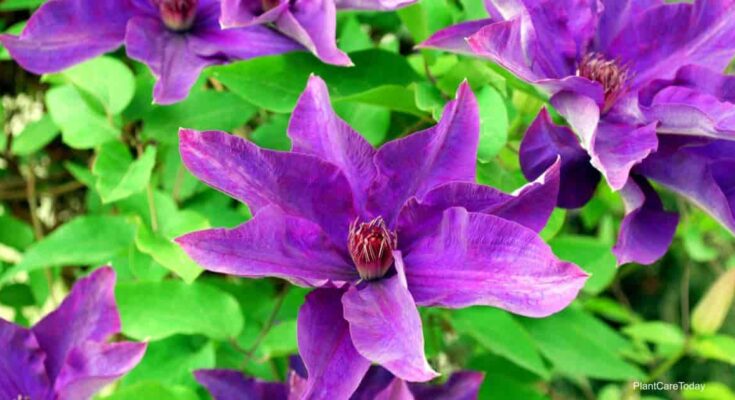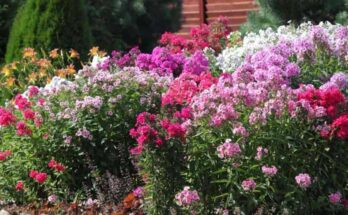Hardy Clematis is a garden favorite that produces stunning masses of flowers from early in the springtime until late autumn. Available in a wide variety of colors and forms.
These bold plants brighten any garden setting, even when space is at a premium, with container gardening the only option. In this article, we share tips to help you grow Clematis in pots. Read on to learn more.
As long as you can provide:
- Full sun (6 hours daily)
- Consistent watering
- Occasional pruning
- A fertile, well-draining soil
- Support (trellis, post, etc.)
- Regular fertilizing
- Shaded roots
Providing these, your Clematis flowers will certainly do well. Experts recommend purchasing container-grown clematis plants with root systems that fill the container.
What Are The Best Varieties Of Clematis For Container Growing?
Several small or dwarf varieties of Clematis can do very well in pots. Among them are:
- Sieboldii is a charming dwarf variety with bi-color blooms in cream with purple centers.
- Nelly Moser is a smallish variety that produces lovely pinkish-purple flowers.
- Polish Spirit is an attractive cultivar with deep blue-violet blossoms.
- The President is a bold choice with deep red blooms.
The smaller varieties of Clematis typically grow about 4″ feet high with a spread of 2-to-4′ feet. Their growth can be controlled and guided with regular pruning.
What Type Of Pot Is Best For Growing Clematis?
Even with the smaller varieties of Clematis, you will need a large pot to accommodate the plant’s roots.
Although it is good to choose a plant with a full, vigorous root system that fills the pot when you buy, once you get the plant home, it will need to be repotted into a container that gives it room to grow.
Extra soil also protects the roots against excessive heat and cold.
If your pot is too small, your plant may survive, but it probably won’t bloom.
Additionally, if the plant becomes root bound, it will be more subject to disease and pest infestation.
Choose a container that is a minimum of fifteen inches wide (at its narrowest point) and 18” inches deep.
The most important quality in a Clematis pot is drainage. You want to be sure that excess water drains away freely.
Choose a container with multiple drainage holes in the bottom (or drill a few extras if you can). A container with feet helps facilitate drainage.
Otherwise, set the container up on a couple of bricks or tiles so water can freely run out of the drain holes.
As far as material goes, you’ll need to consider your climate.
If you live in a scorching climate, terra cotta, wood, or ceramic are better choices because they will help protect the roots against heat.
On the other hand, if you live in a freezing climate, plastic or similar material may be better because it will not crack in freezing temperatures.
Avoid dark-colored containers because they cause the plant’s roots to overheat in hot weather.
How Do You Pot Clematis?
You’ll need a good quality, well-draining, light, airy soil-based potting mix (no peat) with slow-release nutrients.
If it doesn’t include added nutrients, you’ll want to mix in some all-purpose, slow-release fertilizer.
You’ll also need a trellis or other support structure ready to put in place as soon as you get your Clematis transplanted.
It’s important not to wait to install this because once the roots are established, putting a trellis or a climbing pole in place may damage them.
It’s also important for the support structure to be sturdy. Clematis have quite a bit of foliage, so the plant is heavy and needs good support.
Furthermore, if you live in an area with a lot of wind, a weak support structure may break and cause damage to your plant.
How Do You Take Care Of Clematis In Pots?
Even though Clematis needs excellent drainage, they also need consistently moist soil. A plant that dries out will not rebound easily.
Therefore, provide a thorough, deep watering whenever the top couple inches of soil feels dry.
During the heat of summer, you should probably water every other day. Daily watering is not recommended.
Once your plant is established and starts producing new leaves, fertilize every couple of weeks using a fertilizer that provides equal amounts of nitrogen and potash.
When your plant sets buds, stop fertilizing. You can resume fertilizing again early in the springtime.
If you prefer to fertilize less frequently, you can provide feeding of slow-release, all-purpose fertilizer when your plant begins to show new foliage growth (early spring) and then repeat the treatment at the start of summer and mid-summer.
Do You Have To Bring Potted Clematis Indoors In Winter?
A healthy plant in an appropriately large and sturdy pot should be fine outdoors in winter, even in a freezing climate.
However, you may want to move it to a sheltered setting (e.g., near a wall or in a corner).
Add a layer of mulch over the top of the soil to help protect the roots against freezing.
In Many Cases, Clematis Grow Better In Pots!
Clematis can make a very happy potted plant with the right choices in plants, potting medium, and container.
Containment growing may be your only choice if you have a tiny garden space, such as a balcony, patio, or terrace.
It is impossible to grow Clematis directly in the soil if the drainage is poor or the water table is very high.
Follow the advice presented here for success when growing Clematis in pots.
Source link
Originally posted 2022-09-16 17:02:28.





